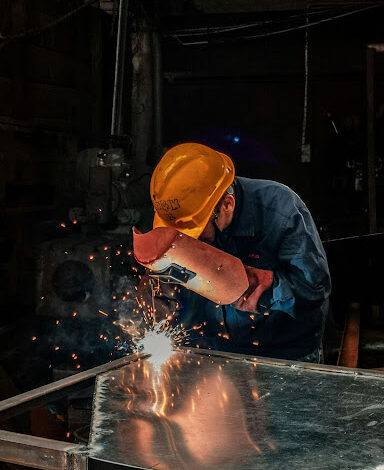Politics
Importance of Stainless Steel Fabrication: A Complete Guide

Have you ever wondered what is used in modern buildings to make them strong and sleek? Or how the spotless handrails on your exterior deck have been made? The answer lies in stainless steel fabrication. This process transforms raw stainless steel into the structures and products we rely on daily.
Steel fabrication is more than just metalwork. It’s the foundation of countless industries in Melbourne and beyond. From towering skyscrapers to precision medical equipment, this material is made into several items that shape our world. Understanding this process can help you make informed decisions for your projects.
In this blog, we’ll discuss stainless fabrication, the difference between basic steel and stainless steel, how they’re machined and their applications. Knowing the basics will save you time and money, whether you’re planning construction work or need custom components.
What Is Steel Fabrication?
Steel fabrication is the process of shaping and joining steel for practical use. Fabricators cut raw material to size before bending or forming the sheets into the required shapes. These pieces are then welded or bolted together to form complete assemblies. Other steps include drilling, finishing and testing. The final output can be frames, components or complete structures for buildings, factories, machinery and more.
Key Differences between Steel and Stainless Steel
Regular steel and stainless steel are related and hence quite similar, but they’re completely different materials. Steel is primarily an alloy of iron mixed with carbon. This combination gives it immense strength but leaves the material vulnerable to rust and corrosion.
Stainless steel, on the other hand, is made differently. It also contains iron, carbon, and an extra addition—at least 10.5% chromium. This creates an invisible protective layer on the surface that prevents rust when exposed to oxygen.
However, the differences don’t end there. They go beyond just corrosion resistance. Stainless steel maintains its appearance longer and better handles temperature changes. It also offers superior hygiene properties, making it perfect for medical and food industry applications. These advantages make stainless steel the preferred choice for demanding environments where regular steel simply won’t perform.
Why Stainless Steel Fabrication Matters?
Stainless steel fabrication plays a crucial role in modern manufacturing and construction. The material’s unique properties make it indispensable across numerous industries. Structures last for decades without major maintenance thanks to the impressive corrosion resistance. This durability translates to significant cost savings over time.
Melbourne’s harsh weather conditions make structural stainless steel fabrication particularly valuable. It can withstand moisture, salt air and temperature fluctuations without degrading. This resilience makes it perfect for coastal construction projects and outdoor installations, too.
The versatility of stainless steel extends to precision work as well. Medical devices, food processing equipment and pharmaceutical machinery all rely on the hygienic properties of stainless steel. The material doesn’t harbour bacteria or react to chemicals, ensuring safety in critical applications. From water treatment systems to architectural features, stainless steel fabrication provides solutions that regular steel simply cannot match.
Common Types of Stainless Steel Fabrication
Stainless steel is prized for its strength, durability, and corrosion resistance, yet shaping it demands specialised techniques. Depending on your project, a combination of processes may be used to achieve the required finish. Here are some common methods employed in stainless steel fabrication:
● Work Hardening: Work hardening reinforces stainless steel by applying mechanical stress. Bending, rolling, or twisting the metal alters its internal structure, enhancing resilience without changing its composition. This is often used in structural stainless steel fabrication when increased toughness is needed.
● Metal Stamping: Stamping uses dies and presses to form sheets into specific shapes. It’s a high-speed, accurate technique that plays a key role in modern steel fabrication, especially for producing large volumes with consistent quality.
● Welding: Welding permanently joins components using heat and sometimes pressure. High temperatures melt the metal edges, and filler material is used to fill the gaps, forming a robust connection. Strong welds are vital in stainless fabrication for structural and industrial applications.
● Punching: Punching creates precise openings in the sheets via a press and die setup. This method is employed when holes or cut-outs are needed for aesthetics or functionality. This is fundamental to integrating features in both general stainless steel fabrication and specialised applications.
● Machining: Machining employs tools like drills, lathes, or milling machines to remove extra material and refine shapes. It delivers complex details that are challenging to do by hand. Many steel fabrication projects rely on machining to ensure a precise fit and finish.
● Soldering and Brazing: For thin or delicate components, soldering and brazing provide lower-heat alternatives to welding. Filler materials with lower melting points are used to join pieces without compromising surrounding areas. These methods are valued in structural stainless steel fabrication when precision is paramount.
● Laser Cutting: Laser cutting uses high-precision beams to slice stainless steel cleanly. It reduces waste, allows precise cuts and delivers superior edge quality. This makes it increasingly popular in modern stainless fabrication across diverse industries.
From mechanical reinforcement to precise, laser-guided shaping, contemporary fabrication blends traditional and modern methods. These processes are at the core of stainless steel fabrication, ensuring products—from structural frameworks to custom pieces—are strong, precise and high quality.
Applications of Stainless Steel Fabrication
Stainless fabrication plays a role in many industries, across different sectors, including:
● Construction and Architecture: Modern buildings rely heavily on steel fabrication. From handrails and facades to structural frames, stainless steel offers both strength and style. It resists weathering, holds its shape well, and retains a modern look for decades. That’s why architects and builders in Melbourne often rely on it for such projects.
● Automotive Industry: Car manufacturers use this method on exhaust systems, trim pieces and structural components. The heat resistance makes it perfect for high-temperature applications. Plus, its anti-corrosion property ensures parts last throughout a vehicle’s lifetime, even in harsh driving conditions.
● Food and Pharmaceutical Industries: These industries require the highest hygiene standards. Stainless steel fabrication provides surfaces that resist bacterial growth and chemical reactions. Processing equipment, storage tanks and conveyor systems all rely on this particular property. The material’s non-reactive nature ensures product purity and safety at all times.
Benefits of Stainless Steel Fabrication
Stainless steel has become the preferred material across various industries due to the balance it offers between performance, durability, and long-term value. Below are some of the key benefits that make stainless steel fabrication a reliable choice for several projects:
● Durability and Longevity: One of the biggest advantages of stainless steel is its durability. The chromium in the alloy forms a natural protective layer that resists rust and corrosion. This means it retains strength even when exposed to moisture, chemicals or harsh outdoor conditions. Structures and components made from the material often last longer than those made from other alternatives, reducing the need for frequent replacements.
● Low Maintenance Requirements: Unlike coated or painted steel, stainless steel does not need a regular recoat to maintain its performance. A simple cleaning routine is often enough to keep it in good condition. This saves time and reduces labour costs over the life of the structure.
● Hygienic Properties: The smooth, non-porous surface of stainless steel makes it easy to clean and resistant to bacterial growth. This makes it the preferred choice for industries where hygiene cannot be compromised, such as food processing, healthcare and the pharmaceutical industry. These surfaces can also withstand frequent sterilisation without losing strength or appearance, supporting compliance with strict health and safety standards.
● Sustainability and Recyclability: Stainless steel is one of the most sustainable materials for building and manufacturing. It often contains a high percentage of recycled content and can be recycled repeatedly without losing its properties. The long lifespan also means fewer resources are used on replacements, lowering overall environmental impact.
● Cost-effectiveness: Although stainless steel may initially cost more than plain steel, it proves more economical over time. The low maintenance needs and long lifespan balance out the higher upfront expense. Hence, projects that use stainless steel benefit from fewer repairs, less downtime and better value in the long run.
Contact Gunceler Industries for Stainless Steel Fabrication Today
Gunceler Industries has been a trusted name in stainless steel fabrication across Melbourne for nearly a decade. Their licensed team handles everything from precision cutting to machining and welding for all types of projects. With strong local knowledge and a focus on timely delivery, they keep projects on track from start to finish.
Their team is fully licensed and insured. Additionally, they are also known for clear communication, flexible service and delivering on time. To discuss your project, call them on 0411 032 421 or email them at guncelerIndustries@hotmail.com for details.
————————————————————————————————————————-
The post Importance of Stainless Steel Fabrication: A Complete Guide appeared first on MyNewsGh.





